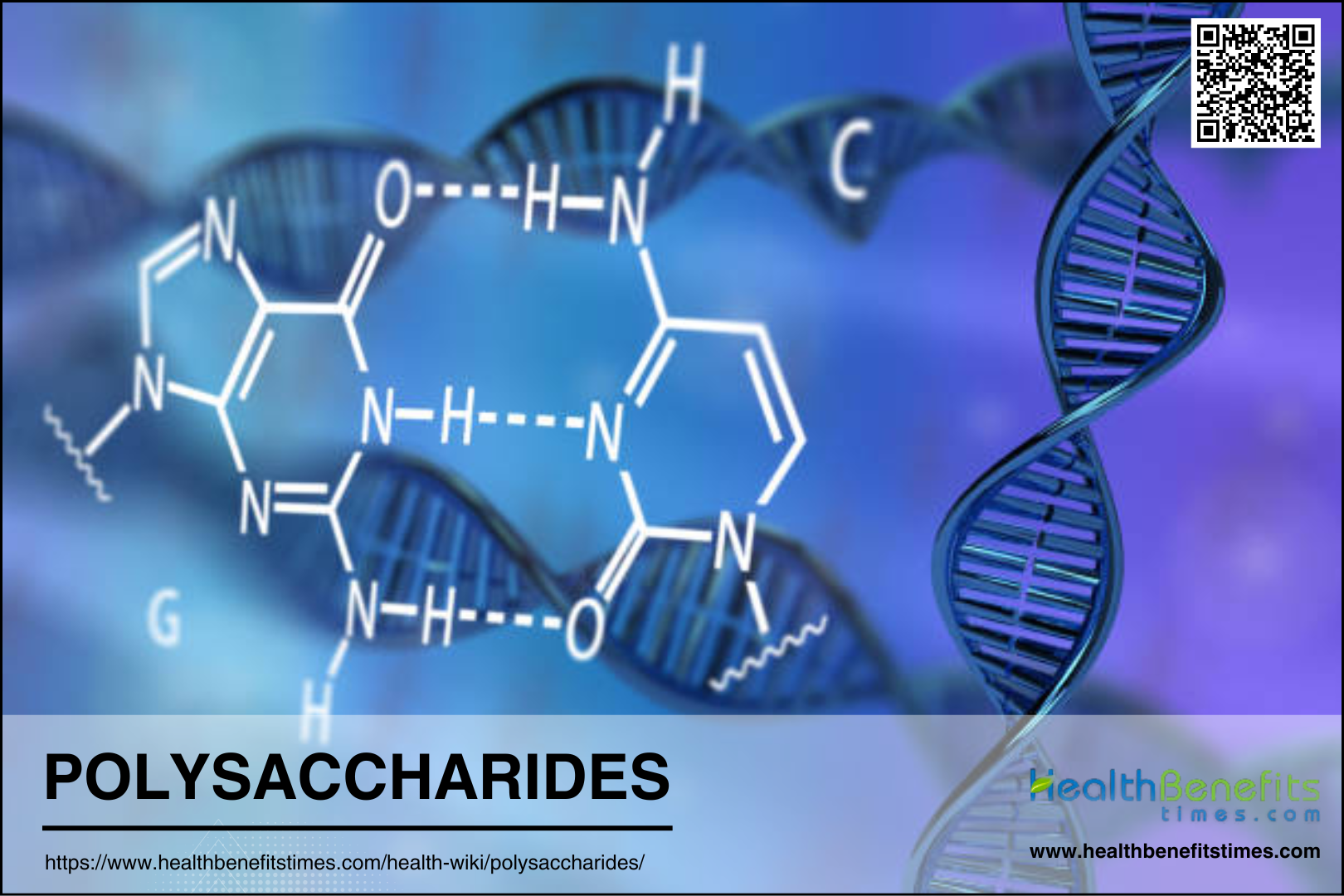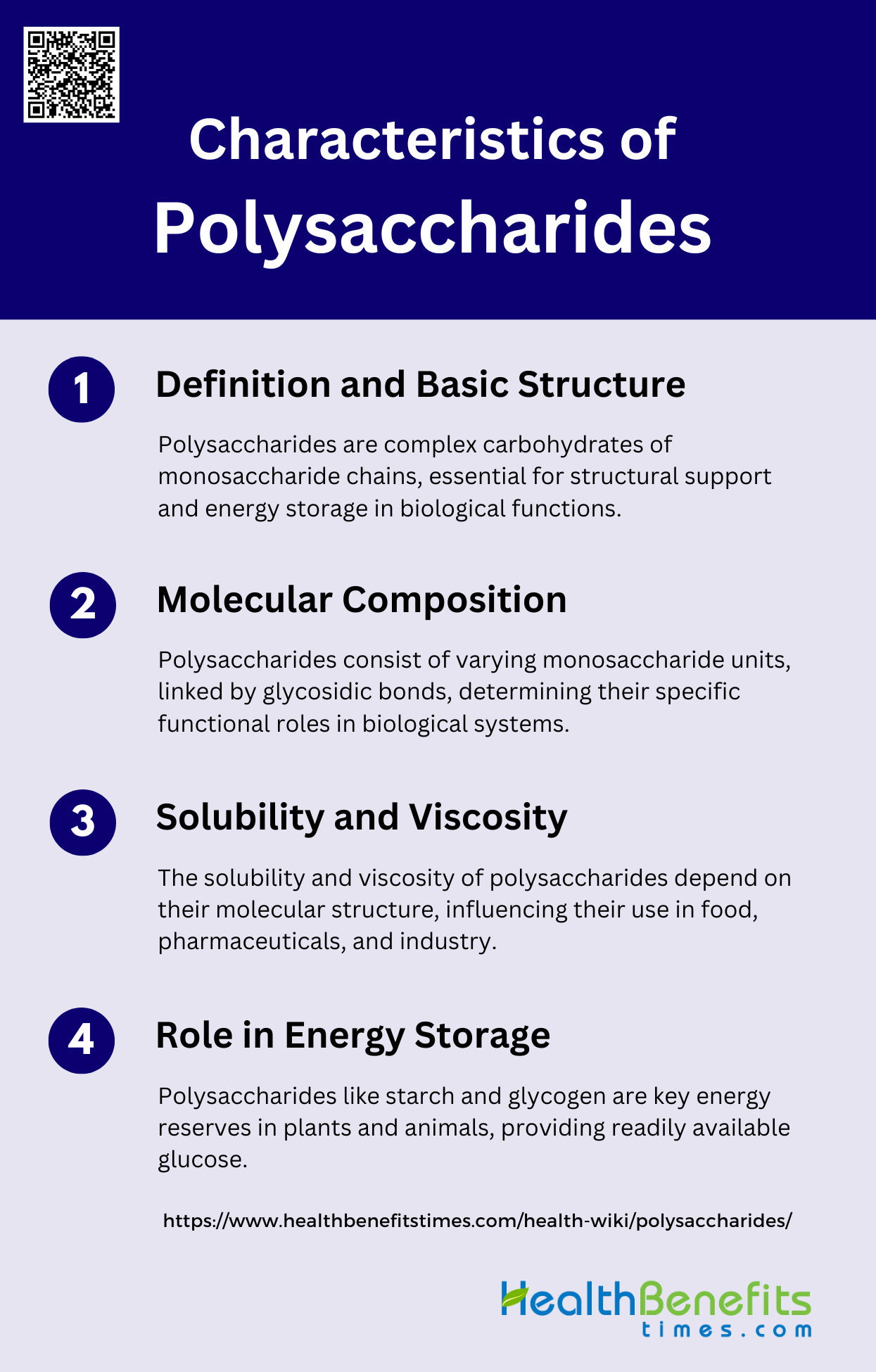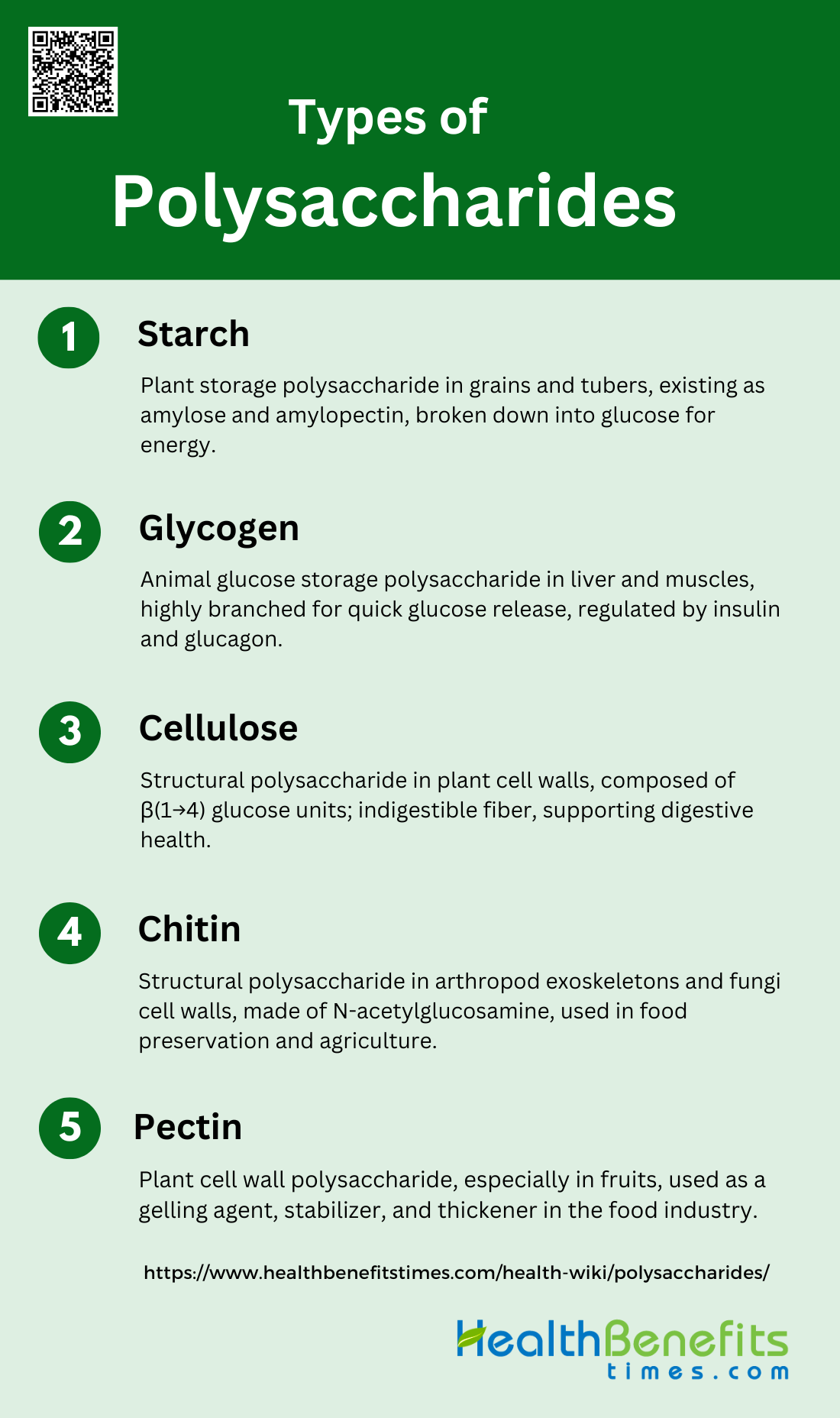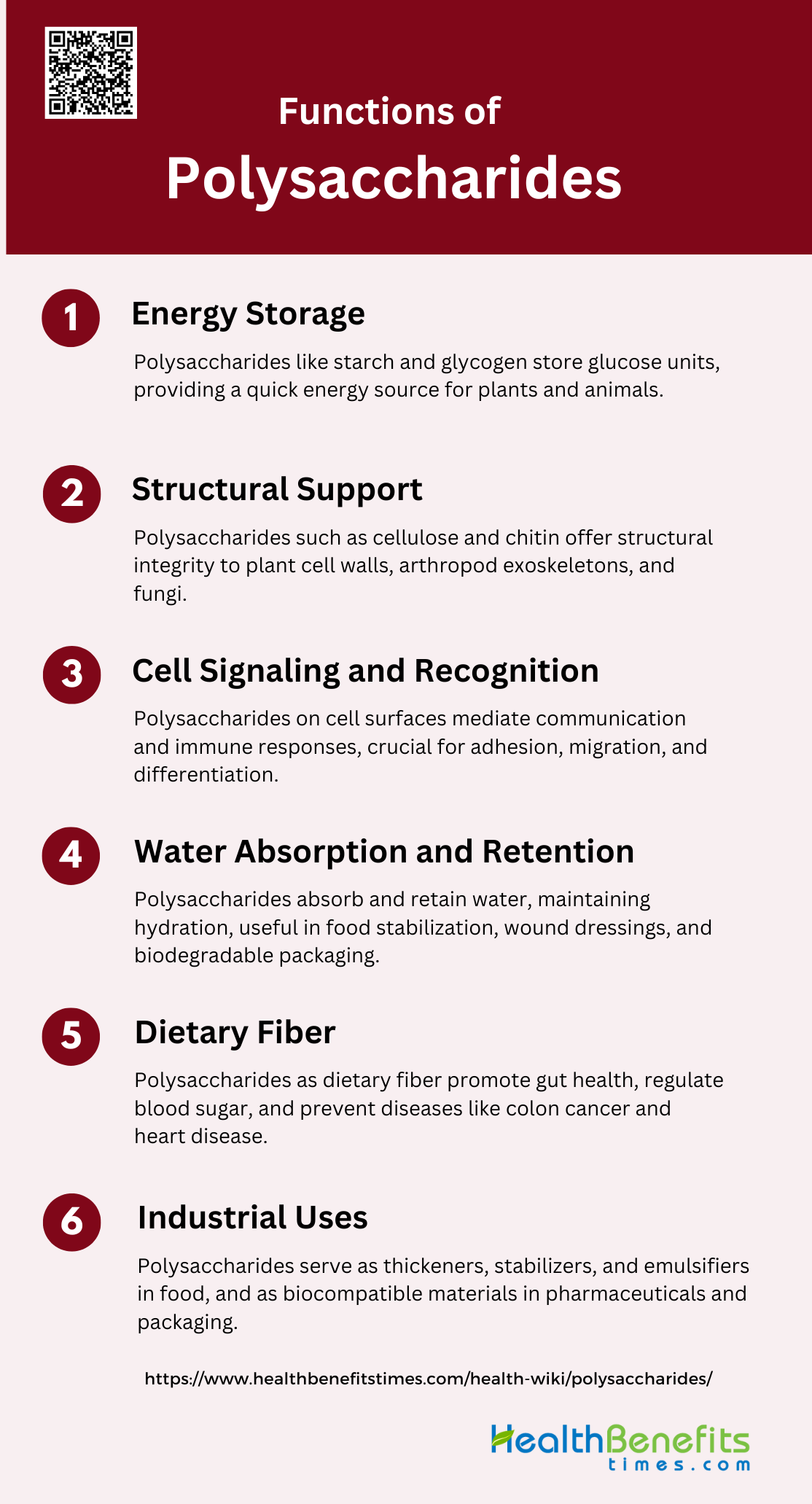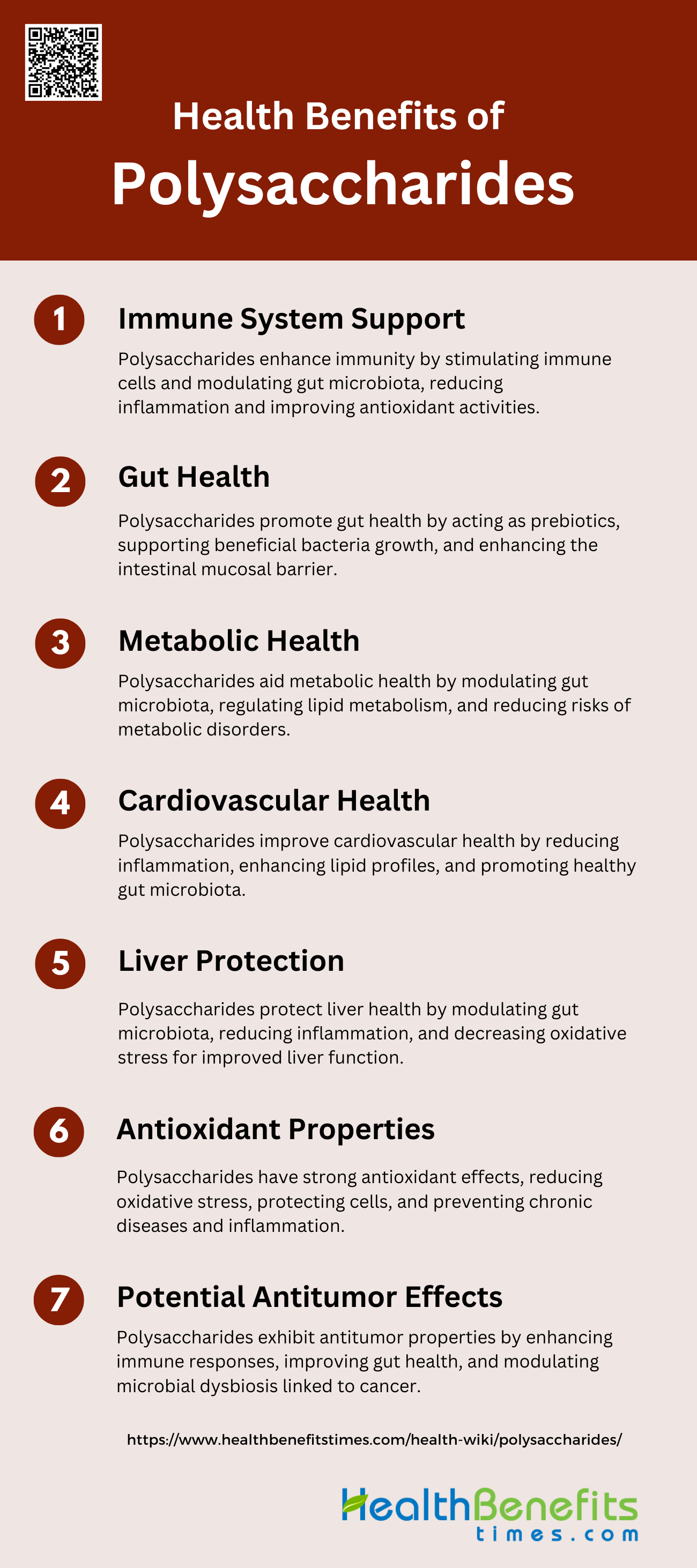Polysaccharides are essential macromolecules found in almost all living organisms, playing crucial roles in various biological functions. They are composed of long chains of monosaccharides linked by glycosidic bonds and can be derived from diverse sources such as plants, microorganisms, algae, and animals. These complex carbohydrates exhibit a wide range of biological and pharmacological activities, including anti-tumor, immunomodulatory, antimicrobial, antioxidant, anticoagulant, antidiabetic, antiviral, and hypoglycemic properties, making them highly valuable in biomedical and pharmaceutical fields. Polysaccharides are also significant in human nutrition, contributing to bowel health and the modulation of gut microbiota through their fermentative products, such as short-chain fatty acids. Chemical modifications of polysaccharides can enhance their bioactivity and introduce new functionalities, further expanding their applications in therapeutic delivery systems and tissue engineering. The versatility and broad spectrum of activities of polysaccharides underscore their potential as alternatives to conventional therapies and their importance in advancing health and medical sciences.
Characteristics of Polysaccharides
Polysaccharides are complex carbohydrates that play vital roles in biological systems. They are composed of long chains of monosaccharides and exhibit diverse properties depending on their structure and composition. Below, we explore the key characteristics of polysaccharides in detail.
1. Definition and Basic Structure
Polysaccharides are complex carbohydrates composed of long chains of monosaccharide units linked together by glycosidic bonds. These biopolymers are essential for various biological functions, including structural support and energy storage. For instance, cellulose, a β (1→4) linked glucose polymer, forms rigid fibrils that provide structural integrity to plant cell walls, while amylose, an α (1→4) linked glucose polymer, forms softer structures used for energy storage. The structural diversity of polysaccharides arises from the different types of monosaccharides involved and the variations in glycosidic linkages, which result in a wide range of physical and chemical properties.
2. Molecular Composition
These monosaccharides can include glucose, galactose, mannose, and others, depending on the specific polysaccharide. The molecular composition can vary significantly, leading to different functional properties. For example, starch and glycogen are primarily composed of glucose units, while other polysaccharides like pectins and alginates include a variety of monosaccharides and uronic acids. The specific arrangement and type of monosaccharides determine the polysaccharide’s role in biological systems, such as energy storage or structural support.
3. Solubility and Viscosity
The solubility and viscosity of polysaccharides are influenced by their molecular structure, including the type of monosaccharides, the degree of polymerization, and the nature of the glycosidic linkages. Polysaccharides like starch and glycogen are generally soluble in water and form viscous solutions, which makes them suitable for energy storage and food applications. In contrast, polysaccharides such as cellulose and chitin are insoluble in water due to their highly ordered, crystalline structures, which provide mechanical strength and rigidity. The solubility and viscosity also affect their functional properties in food systems, pharmaceuticals, and other industrial applications.
4. Role in Energy Storage
Polysaccharides play a crucial role in energy storage in both plants and animals. Starch, found in plants, and glycogen, found in animals, are the primary storage polysaccharides. These polysaccharides are composed of glucose units linked by α (1→4) and α (1→6) glycosidic bonds, allowing them to be easily broken down into glucose when energy is needed. The branched structure of glycogen provides a rapid release of glucose, making it an efficient energy reserve for animals. Similarly, starch, which includes amylose and amylopectin, serves as a major energy source in the human diet, contributing significantly to caloric intake.
Types of Polysaccharides
Polysaccharides are diverse macromolecules that serve various functions in living organisms. They can be classified into different types based on their structure and role. Below, we outline the main types of polysaccharides.
1. Starch
Starch is a primary storage polysaccharide in plants, predominantly found in grains, tubers, and legumes. It exists in two forms: amylose, which is a linear polymer, and amylopectin, a highly branched polymer. During digestion, enzymes like amylase break down starch into glucose, which is then absorbed and metabolized to provide energy.
2. Glycogen
Glycogen serves as the main storage form of glucose in animals, primarily stored in the liver and muscles. It is a highly branched polysaccharide, allowing for rapid release of glucose when energy is needed. Glycogen breakdown is regulated by hormones like insulin and glucagon, ensuring a steady supply of glucose.
3. Cellulose
Cellulose is a structural polysaccharide found in the cell walls of plants, providing rigidity and strength. It is composed of β(1→4) linked glucose units, forming long, fibrous chains. Cellulose is a major component of dietary fiber, aiding in digestive health, although it is indigestible by humans.
4. Chitin
Chitin is a structural polysaccharide found in the exoskeletons of arthropods and the cell walls of fungi. It is composed of N-acetylglucosamine units. Chitin and its derivative, chitosan, have various applications, including in food preservation and as biocontrol agents in agriculture.
5. Pectin
Pectin is a polysaccharide found in the cell walls of plants, particularly in fruits. It plays a crucial role in plant structure and is widely used in the food industry as a gelling agent, stabilizer, and thickener. Pectin’s ability to form gels makes it valuable in the production of jams and jellies.
Functions of Polysaccharides
Polysaccharides play crucial roles in various biological processes, from energy storage to providing structural integrity. Their diverse functions are essential for the proper functioning of living organisms. Below, we detail the primary functions of polysaccharides.
1. Energy Storage
Polysaccharides play a crucial role in energy storage in both plants and animals. Starch and glycogen are prime examples of storage polysaccharides. Starch, found in plants, consists of amylose and amylopectin, which store glucose units for later use. Glycogen, the animal equivalent, is stored in liver and muscle tissues and can be rapidly mobilized to meet energy demands. These polysaccharides are composed of α (1→4) linked glucose units, which allow them to be easily broken down by enzymes to release glucose, providing a quick source of energy.
2. Structural Support
Cellulose, a β (1→4) linked glucose polymer, is a key component of plant cell walls, giving them rigidity and strength. Chitin, another structural polysaccharide, is found in the exoskeletons of arthropods and the cell walls of fungi, providing similar support and protection. These polysaccharides form tightly packed, fibrous structures that are resistant to mechanical stress, making them ideal for structural roles in nature.
3. Cell Signaling and Recognition
Polysaccharides are involved in cell signaling and recognition processes. They are often found on the cell surface, where they interact with proteins and other molecules to mediate cellular communication and immune responses. For example, glycosaminoglycans like hyaluronan play a role in cell signaling and modulating the extracellular matrix in vertebrates. These interactions are crucial for processes such as cell adhesion, migration, and differentiation.
4. Water Absorption and Retention
Polysaccharides are highly effective at absorbing and retaining water, which is essential for maintaining cellular hydration and structural integrity. For instance, sacran, a cyanobacterial polysaccharide, can form twisted fibers that exhibit remarkable water retention properties. This ability to hold water makes polysaccharides valuable in various applications, including food stabilization, wound dressings, and biodegradable packaging. Their hydrophilic nature allows them to form gels and viscous solutions, which are beneficial in both biological and industrial contexts.
5. Dietary Fiber
Dietary fiber, primarily composed of polysaccharides, plays a significant role in human health. Cell wall polysaccharides from plant foods, such as cellulose, hemicellulose, and pectin, contribute to dietary fiber. These fibers are not digested by human enzymes but are fermented by gut microbiota, promoting gut health and preventing diseases like colon cancer and cardiovascular diseases. They also aid in regulating blood sugar levels and improving bowel movements, making them essential components of a healthy diet.
6. Industrial Uses
They are used as thickeners, stabilizers, and emulsifiers in the food industry, and as biodegradable materials in packaging and textiles. Microbial polysaccharides like levan are particularly promising due to their high productivity and versatility. These biopolymers are also used in pharmaceuticals for drug delivery, wound healing, and tissue engineering, thanks to their biocompatibility and functional properties. The ongoing research and development in this field continue to expand the potential industrial uses of polysaccharides.
Health Benefits of Polysaccharides
Polysaccharides are complex carbohydrates that offer a wide range of health benefits. These naturally occurring compounds are found in various foods and medicinal plants, and they play crucial roles in supporting overall health. Below are some of the key health benefits of polysaccharides:
1. Immune System Support
Polysaccharides have been shown to significantly enhance immune system function. They can stimulate various immune cells, including natural killer cells, T-cells, B-cells, neutrophils, and macrophages, through different receptors such as dectin-1 and toll-like receptor-2. Additionally, polysaccharides can modulate gut microbiota, which in turn influences immune responses. For instance, Lycium barbarum polysaccharides (LBPs) have been found to enhance immunity by promoting beneficial microorganisms and strengthening immune cell functions. Moreover, natural polysaccharides can suppress excessive inflammatory responses by improving intestinal microbiota composition and enhancing antioxidant activities.
2. Gut Health
Polysaccharides play a crucial role in maintaining and improving gut health. They serve as prebiotics, promoting the growth of beneficial gut bacteria and enhancing the production of short-chain fatty acids (SCFAs), which are vital for gut health. Edible mushroom polysaccharides (EMPs) have been shown to positively impact gut microbiota composition, promoting the growth of beneficial bacteria and improving the intestinal mucosal barrier. Additionally, polysaccharides can modulate the gut microbiota ecosystem, thereby improving bowel health and reducing inflammation. These effects collectively contribute to a healthier gut environment and better overall digestive health.
3. Metabolic Health
Polysaccharides have demonstrated significant benefits for metabolic health, particularly in the management of metabolic syndrome. Lycium barbarum polysaccharides (LBPs) have been shown to positively influence metabolic health by modulating gut microbiota, which in turn affects obesity, type 2 diabetes, and nonalcoholic fatty liver disease. Mushroom polysaccharides can also alleviate metabolic diseases by regulating lipid metabolism and activating specific signaling pathways. These polysaccharides help in maintaining a balanced gut microbiota, which is crucial for metabolic health, thereby reducing the risk of metabolic disorders.
4. Cardiovascular Health
The production of SCFAs through the fermentation of polysaccharides by gut bacteria has been linked to improved lipid profiles and reduced inflammation, both of which are beneficial for cardiovascular health. Additionally, the anti-inflammatory properties of polysaccharides can help in reducing the risk of cardiovascular diseases by lowering systemic inflammation. By promoting a healthy gut microbiota and reducing inflammation, polysaccharides play a vital role in maintaining cardiovascular health.
5. Liver Protection
Polysaccharides have shown potential in protecting liver health, particularly through their effects on gut microbiota and metabolic functions. Lycium barbarum polysaccharides (LBPs) have been found to alleviate nonalcoholic fatty liver disease by modulating gut microbiota and reducing inflammation. The improvement in gut health and reduction in systemic inflammation contribute to better liver function and protection against liver diseases. Additionally, the antioxidant properties of polysaccharides help in reducing oxidative stress, which is beneficial for liver health.
6. Antioxidant Properties
Polysaccharides possess strong antioxidant properties, which help in reducing oxidative stress and protecting cells from damage. These properties are particularly beneficial in preventing chronic diseases and improving overall health. For instance, natural polysaccharides can enhance antioxidant activities, thereby reducing pro-inflammatory mediators and improving the intestinal microenvironment. Bacterial polysaccharides have also shown antioxidant abilities, which contribute to their therapeutic effects against various illnesses. The antioxidant properties of polysaccharides play a crucial role in maintaining cellular health and preventing oxidative damage.
7. Potential Antitumor Effects
Natural polysaccharides can enhance immune responses and improve gut health, creating an environment that lowers the risk of tumor development. Mushroom polysaccharides, such as β-glucans, have shown potent antitumor and immunostimulating properties by activating various immune cells. Additionally, the modulation of gut microbiota by polysaccharides can reverse microbial dysbiosis, which is often associated with tumorigenesis, thereby reducing the risk of cancer.
Sources of Polysaccharides in Diet
They can be sourced from both plant-based and animal-based foods, each offering unique nutritional advantages. Below are the primary sources of polysaccharides in the diet:
1. Plant Based sources
Polysaccharides are abundant in plant-based foods, providing essential nutrients and health benefits. Below are some plant based sources of Polysaccharides:
- Cereal Grains: Cereal grains such as wheat, rice, and corn are rich sources of polysaccharides, primarily in the form of starch and cell wall polysaccharides. These components contribute significantly to dietary fiber, which is associated with various health benefits, including reduced risks of obesity, type 2 diabetes, and cardiovascular diseases.
- Starchy Vegetables: Starchy vegetables like potatoes, sweet potatoes, and yams are excellent sources of polysaccharides, mainly starch. These vegetables provide a substantial amount of energy and are also rich in dietary fiber, which aids in digestion and helps maintain stable blood sugar levels.
- Legumes: Legumes, including beans, lentils, and peas, are notable for their high polysaccharide content, particularly in the form of galacto-oligosaccharides and resistant starch. These polysaccharides contribute to the legumes’ health benefits, such as improved gut health and reduced risk of chronic diseases.
- Fruits and Vegetables: Fruits and vegetables are abundant in various polysaccharides, including pectins, cellulose, and hemicelluloses. These polysaccharides are known for their biological activities, such as lowering blood sugar and lipids, and their role in enhancing the stability and bioavailability of other nutrients.
- Whole Grains: Whole grains, such as oats, barley, and quinoa, contain high levels of dietary fiber polysaccharides, including beta-glucans and arabinoxylans. These polysaccharides are linked to numerous health benefits, including improved digestion, reduced cholesterol levels, and enhanced immune function.
2. Animal-Based Sources
While plant-based sources are more common, polysaccharides can also be found in animal-based foods. Animal-based polysaccharides contribute to a balanced diet and offer unique nutritional advantages. Below are two types of animal-based sources of Polysaccharides:
- Glycogen: Glycogen is the primary polysaccharide found in animal tissues, particularly in the liver and muscles. It serves as a crucial energy reserve that can be rapidly mobilized to meet the body’s energy demands during physical activity or fasting.
- Chitin: Chitin is a polysaccharide found in the exoskeletons of crustaceans, insects, and some fungi. While not a common dietary component, chitin and its derivatives, such as chitosan, have been studied for their potential health benefits, including antimicrobial properties and their role in weight management.
Industrial and Practical Applications of Polysaccharides
Food Industry
Polysaccharides are extensively used in the food industry as thickeners and stabilizers due to their ability to modify the properties of aqueous environments. They can thicken, emulsify, stabilize, and form gels, which are essential for creating desirable textures in food products. Acetylated polysaccharides, for instance, enhance the physicochemical properties and biological activities of food products, making them valuable as gelling agents and health supplements. Additionally, microbial levan, a fructose polysaccharide, is noted for its film-forming ability and biodegradability, making it an attractive candidate for food production. These properties ensure that polysaccharides play a crucial role in maintaining the quality and stability of various food items.
Pharmaceutical Applications
In the pharmaceutical industry, polysaccharides are pivotal in drug delivery and formulation due to their biocompatibility, biodegradability, and non-toxicity. They are used to create micro/nanoparticles for controlled drug delivery systems, enhancing the efficacy and stability of therapeutic agents. Marine polysaccharides from algae, for example, are utilized in controlled drug delivery, wound management, and regenerative medicine due to their unique bioactive properties. Furthermore, polysaccharides like chitosan and alginate are employed in drug/gene delivery, tissue engineering, and wound healing, highlighting their versatility and importance in developing advanced pharmaceutical applications.
Biotechnology and Research
Polysaccharides are invaluable in biotechnology and research, serving as experimental and practical tools due to their diverse functional properties. They are used in the development of biopolymers for biomedical applications, including tissue engineering, infection control, and wound healing. The manipulation of polysaccharides at the nanoscale has expanded their potential applications, particularly in drug delivery and vaccine adjuvants. Additionally, the use of polysaccharides in 3D printing for drug delivery applications showcases their versatility and adaptability in creating personalized pharmaceutical treatments. These applications underscore the significant role of polysaccharides in advancing biotechnological research and innovation.
FAQs
1. What are the differences between soluble and insoluble polysaccharides?
The article mentions the solubility of some polysaccharides (like starch and glycogen) but does not clearly differentiate between soluble and insoluble polysaccharides and their respective roles in human health and nutrition.
2. How do polysaccharides affect blood sugar levels in diabetics?
While the article talks about the health benefits of polysaccharides, including their hypoglycemic properties, it does not specifically address how they impact blood sugar levels in people with diabetes or their potential use in managing diabetic conditions.
3. Are there any potential side effects or risks associated with consuming polysaccharides?
The article highlights the health benefits of polysaccharides but does not discuss any potential side effects or risks, such as digestive issues or allergic reactions, that may arise from their consumption.
4. Can polysaccharides be used as dietary supplements, and if so, which ones are most commonly used?
Although the article mentions the benefits of polysaccharides in various contexts, it does not specifically address their use as dietary supplements or which types of polysaccharides are most frequently used in supplement form.
5. What is the role of polysaccharides in cosmetic or skincare products?
The article talks about the use of polysaccharides in biomedical and pharmaceutical fields but does not discuss their applications in cosmetics or skincare, where they might be used for hydration, anti-aging, or other skin benefits.
6. How do polysaccharides contribute to gut health beyond their prebiotic effects?
While the article states that polysaccharides can serve as prebiotics, it does not elaborate on other specific mechanisms by which they support gut health, such as their impact on the gut lining or their ability to modulate immune responses in the gut.
7. How are polysaccharides extracted or processed from natural sources for industrial use?
The article covers the industrial applications of polysaccharides but does not explain the extraction or processing methods used to obtain polysaccharides from natural sources like plants, algae, or fungi.
8. What are the current trends or advancements in polysaccharide research?
The article mentions ongoing research but does not delve into specific trends, such as the development of novel polysaccharides, advancements in extraction methods, or breakthroughs in understanding their mechanisms of action.
9. Are all polysaccharides biodegradable, and what factors influence their biodegradability?
The article touches on the use of polysaccharides in biodegradable materials but does not clarify whether all polysaccharides are biodegradable or what factors (such as chemical structure or environmental conditions) affect their biodegradability.
10. What are the differences between natural and synthetic polysaccharides, and how do their applications vary?
The article focuses on natural polysaccharides but does not address the differences between natural and synthetic polysaccharides or their specific applications in various industries.


